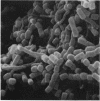Abstract
Two strains of Streptomyces sp. (isolates 275 and 124) were isolated from soil samples collected from the fields around Lewiston, Idaho. Based on their cellular morphology and physiology, the two isolates were identified as Streptomyces albovinaceous. Both isolates produced an antibiotic when grown in liquid culture medium containing homogenized oats. The antibiotic (treponemycin) was isolated from the culture broth by solvent extraction and purified by silica gel column and preparative thin-layer chromatographies. Treponemycin is a crystalline light-yellow compound with an mp of 93 to 95 degrees C, levorotatory, and soluble in most organic solvents. It is sparingly soluble in water but insoluble in petroleum ether. On the basis of elemental analysis and mass spectral data, the molecular formula of the antibiotic was deduced to be C28H43O6N. The infrared spectrum of the antibiotic indicated the presence of unsaturation, nitrile, lactone, or ester or all three functions, and carbonyl functions in the molecule. A sharp infrared absorption band for nitrile at 2,220 cm-1 and the presence of an unsaturated group indicated that the nitrile function may be attached to an unsaturated carbon atom. The presence of dienenitrile functions was further supported by the UV absorption spectrum of the antibiotic, which gave a UVmax at 257 nm. The proton magnetic resonance spectrum of the antibiotic did not give any peak which could be exchanged with deuterated water, which is an indication of the absence of carboxylic and hydroxyl functions in the molecule. All of the functional groupings indicated by the infrared and UV spectra of the molecule were further confirmed by the 13C-magnetic resonance spectrum of the compound. A brief hydrogenation of the antibiotic yielded a biologically active tetrahydro derivative, whereas extended hydrogenation produced an inactive primary amine. Mild alkaline hydrolysis and subsequent esterification of the antibiotic with diazomethane produced an inactive dimethyl ester. Apparently both the nitrile and the lactone functions are essential for the treponomycin molecule to show antimicrobial activity. The antibiotic showed inhibitory activity against several species of bacteria, especially Treponema hyodysenteriae, the causative agent of swine dysentery. In view of the oral 50% lethal dose of 400 mg/g and its low MIC against four stains of T.hyodysenteriae, the antibiotic may have value as a swine dysentery therapeutic.
Full text
PDF






Images in this article
Selected References
These references are in PubMed. This may not be the complete list of references from this article.
- Kinyon J. M., Harris D. L. Growth in Treponema hyodysenteriae in liquid medium. Vet Rec. 1974 Sep 7;95(10):219–220. doi: 10.1136/vr.95.10.219. [DOI] [PubMed] [Google Scholar]
- Marconi G. G., Molloy B. B., Nagarajan R., Martin J. W., Deeter J. B., Occolowitz J. L. A32390A, a new biologically active metabolite. II. Isolation and structure. J Antibiot (Tokyo) 1978 Jan;31(1):27–32. doi: 10.7164/antibiotics.31.27. [DOI] [PubMed] [Google Scholar]
- Pridham T. G., Gottlieb D. The Utilization of Carbon Compounds by Some Actinomycetales as an Aid for Species Determination. J Bacteriol. 1948 Jul;56(1):107–114. doi: 10.1128/jb.56.1.107-114.1948. [DOI] [PMC free article] [PubMed] [Google Scholar]
- Songer J. G., Kinyon J. M., Harris D. L. Selective medium for isolation of Treponema hyodysenteriae. J Clin Microbiol. 1976 Jul;4(1):57–60. doi: 10.1128/jcm.4.1.57-60.1976. [DOI] [PMC free article] [PubMed] [Google Scholar]



